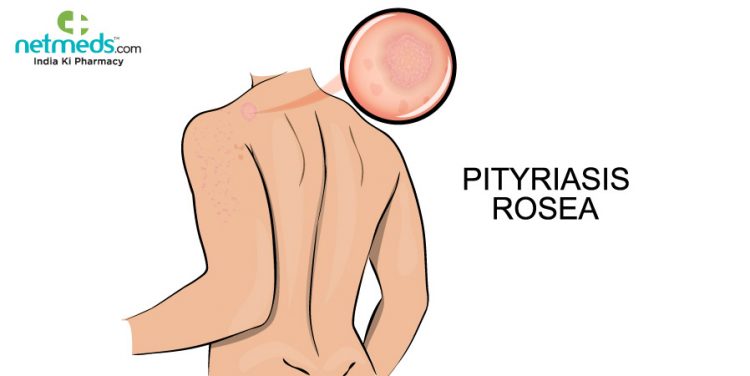Pityriasis rosea is a rash observed as an oval spot on the face, chest, abdomen, or back. This is called a herald patch and may extend up to 4 inches in diameter. And one may also see smaller spots that extend from the middle of the body in a shape like drooping pine-tree branches and rashes can be itchy. This skin disorder can develop at any age but is mostly seen between the ages of 10 and 35. It often settles on its own within 10 weeks. However, proper treatment may help ease the symptoms of pityriasis. The condition is not transmissible and seldom recurs.
Symptoms
Pityriasis rosea typically begins with an oval, slightly raised, scaly patch on the face, back, chest or abdomen- that’s called a herald patch or a mother patch. A few people may experience headache, fatigue, fever, or sore throat before the appearance of the Herald patch.
After a few weeks or days after the appearance of the herald patch, you may see smaller scaly spots across the face, neck, chest, or abdomen which can cause severe itchiness.
Also Read: Pruritus: Causes, Symptoms And Treatment
Causes
The exact cause of pityriasis is still not clear. It may be triggered by a virus infection, mainly by strains of the herpes virus. But it’s not linked to the herpes virus that results in cold sores. This condition is not contagious.
Complications
Severe itching
Temporary spots of skin that are darker or lighter
Diagnosis
In most cases, your dermatologist can determine pityriasis rosea just by looking at the rash. In some cases, your doctor may order a blood test, scrapping, or possibly a skin biopsy, where a small piece of the rash is tested. These tests can help to confirm pityriasis rosea rash from other similar conditions like eczema, ringworm, and psoriasis.
During your appointment, it’s important to tell your dermatologist if you are:
Pregnant
Had an organ transplant
Taking any medications that can cause a rash that looks like pityriasis.
Also Read: Psoriasis: Bid Adieu To Painful Rashes With These Cool DIY Aloe-Infused Gels
Treatment
Pityriasis rosea generally settles on its own without any treatment in a few weeks to months. But if the rash doesn’t fade away by then or if the itching is very severe, then talk with your healthcare provider about treatment options. This condition clears up without leaving any scarring and doesn’t recur.
Medications
Your dermatologist may prescribe corticosteroids and antihistamines to ease symptoms or lessen the duration of pityriasis rosea.
Light Therapy
The patient may also need to take light therapy based on the severity of the condition. In light therapy, the patient is exposed to natural or artificial light that may help ease symptoms. But this therapy may result in lasting spots of skin that are darker than usual, even after the rash clears.
Home Remedies
Following some of these effective self-care measures can help a person alleviate the discomfort associated with pityriasis rosea:
- Bathe or shower in lukewarm water
- Use oatmeal-based bath products to fade away rashes
- Apply moisturizer, calamine lotion, or non-prescription corticosteroid cream
Safeguard the skin from sunlight, by applying a broad range of sunscreen with an SPF of at least 30 even on rainy days. Apply sunscreen liberally and reapply every two hours or often if you’re swimming or sweating
Source by www.netmeds.com




